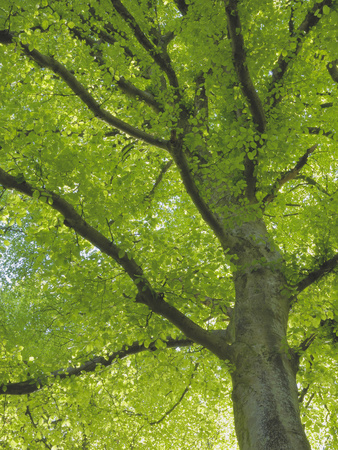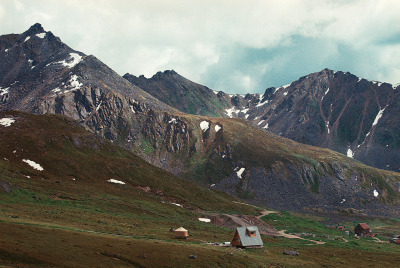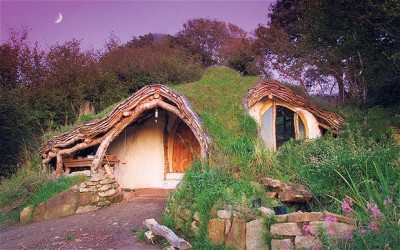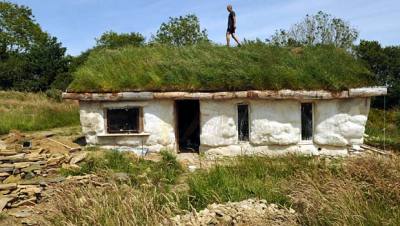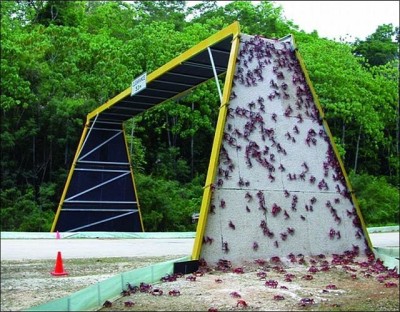28.6.13
Lexiaguo, Southern China
It's real! A mixture of oxidised iron in the soil and disorganised terrace farming has left the landscape of Lexiaguo a patchwork of red, white, green, pink...
25.6.13
Gaudi's 161st Birthday!
Gaudi was the first architect I became aware of and began an obsession with organic architecture that I never really got over. In 2009 I went to Barcelona, mainly to see as many of his designs as I could, and today would have been his 161st birthday, so I'm going to share a few photos from my trip (hopefully not the usual Gaudi postcard photos).
Casa Batlló
Casa Vicens
Park Güell
Park Güell
Some people I don't know at Park Güell
Park Güell
Park Güell
Plant of the week: Lady's mantle
Lady's mantle (Alchemilla mollis) is a hardy herbaceous (dies down after growing season) perennial (pops up again every year) plant, native to southern Europe but grown in UK gardens, with fan shaped leaves and lime green flowers in summer.
I planted Lady's mantle in my parents' garden when I was about 11 and the other day I spotted that it had spread wildly and was covered in water droplets and looked sort of cheerful and exotic. My font of all knowledge (Dad) couldn't remember what it was called but it's name was found after a bit of stealthy googling. Apparently most people find such an easy to grow and exclusively green plant a bit boring, but I'm quite fond of it, though 'Lady's mantle' seems a bit of a fluffy name for such a tough plant.
I planted Lady's mantle in my parents' garden when I was about 11 and the other day I spotted that it had spread wildly and was covered in water droplets and looked sort of cheerful and exotic. My font of all knowledge (Dad) couldn't remember what it was called but it's name was found after a bit of stealthy googling. Apparently most people find such an easy to grow and exclusively green plant a bit boring, but I'm quite fond of it, though 'Lady's mantle' seems a bit of a fluffy name for such a tough plant.
20.6.13
Devil's Bridge
Everything a bit weird gets named the devil's something, doesn't it? This strange set of bridges is in Ceredigion, Wales and the teeny bridge is believed to have been constructed between 1075-1200, the middle bridge in 1753 and the top bridge in 1902.
Aqua Vita Farms
Aqua Vita Farms in Sherrill (Near Syracuse), NY is an indoor seafood and vegetable farm that provides Central New York with fresh food. The farm uses Aquaponics, a combination of fish farming (aquaculture) and growing plants in water (hydroponics) to create a balanced system where the fish provide nutrients for the plants and the plants filter the water, eliminating the need for fertilisers or water changes. Being indoors, the farm doesn't have to rely on seasons - which means all produce, all year round - without the environmental guilt of the miles it's travelled to your plate.
Basically it's a warehouse full of great big tanks of fish and vegetables, that's environmentally friendly and space saving and very clever but also simple. It's also very likely to be a large part of the future of farming.
18.6.13
Plant of the week: Cow parsley vs. Elder
Following a recent incident when I made an arse of myself by insisting Cow parsley (Anthriscus sylvestris) was Ground elder (Aegopodium podagraria), I thought I'd do some research and create a handy guide for myself and any one else that gets pedantic about wild flowers.
Spot the difference.. left: Ground elder, right: Cow parsley
Both plants are found all over the country, have similar flowers and
grow up to 1m and share carrot family heritage, but the most important
similarity is to not confuse either of them with Elder (Sambucus), and get annoyed that your elderberry/elderflower alcohol tastes funny.
Initial research (googling) shows a lot of love for Cow parsley as an 'important link in the food chain', but everyone hates Ground elder; the 'fast-growing, invasive, perennial weed'. The main physical difference in the plants is that Cow parsley has leaves that resemble flat parsley (surprise!), while Ground elder leaves resemble Elder tree leaves (though they're completely unrelated species). People seem to partly hate Ground elder for tricking them in to thinking it's lovely tasty Elder, though Ground elder is edible (though the only tasty part are the young shoots, which is still better than Cow parsley which isn't edible at all). Flowers appear on both plants in May and June but Ground elder carries on blooming until August.
May you never be confused by plants you drive past and hardly notice on country roads again!
Sir Clough Williams-Ellis
Bit too much greenery for Italy, right? This is the fancy little village of Portmeirion, in North Wales, created by Sir Clough William-Ellis. Sir Clough was also fancy and Welsh, and set up his own architecture practise in London after only a few months training when he was 22. He promoted logical strategies for planning and conservation, writing critically about random development after WW1 in England and the Octopus (a book I'd do some pretty obscene things to get my hands on) and he was also instrumental in designating the first National Parks.
From the research I've done, he appears to have been of balanced beliefs; preserve what is useful and beautiful and build more useful and beautiful stuff. It's refreshing to discover someone who is not against development or conservation, shame he died 35 years ago.
From the research I've done, he appears to have been of balanced beliefs; preserve what is useful and beautiful and build more useful and beautiful stuff. It's refreshing to discover someone who is not against development or conservation, shame he died 35 years ago.
10.5.13
Desire lines
I was alerted to the term 'desire lines' by Camera Obscura's new album (can you guess what they've called it?). For those who don't follow Glaswegian indie pop; desire lines are those paths created by people taking shortcuts through woodlands/fields/scraps of planting around retail parks, instead of following the designated paths that Landscape Architects spend most of their waking hours planning, drawing, re-drawing, testing materials for etc (some of us even dream about paths. I'm not even joking).
Rather than seeing desire lines as a direct insult to my sleep deprivation; I follow them. I have been led to such secret locations as: large collections of beer bottles and condoms, stunning views, people's gardens and perfect climbing trees. Which induced experiences of disgust, awe, being chased by dogs and feeling like a fearless child again. Frequently I find myself walking in a large circle or to an excellent patch of grass (livestock make desire lines too, their desires are usually different to mine) but it's always an adventure and reminds me to take some time to discover something new about places I know well, and places I don't.
On one of those sunny days we had at the weekend I followed a desire line to an adorable Scout-camp-weekend-activity-style bridge which was a genuinely delightful experience and reminded me why I risk finding evidence of dogging/grumpy dogs.
Rather than seeing desire lines as a direct insult to my sleep deprivation; I follow them. I have been led to such secret locations as: large collections of beer bottles and condoms, stunning views, people's gardens and perfect climbing trees. Which induced experiences of disgust, awe, being chased by dogs and feeling like a fearless child again. Frequently I find myself walking in a large circle or to an excellent patch of grass (livestock make desire lines too, their desires are usually different to mine) but it's always an adventure and reminds me to take some time to discover something new about places I know well, and places I don't.
On one of those sunny days we had at the weekend I followed a desire line to an adorable Scout-camp-weekend-activity-style bridge which was a genuinely delightful experience and reminded me why I risk finding evidence of dogging/grumpy dogs.
Plant of the week: Beech tree
I always forget about Beech trees (especially in winter when they're quietly all around me with their smooth bark that leads me to confuse them with Sycamores (a heinous crime)). But now there's been a couple of days of sunshine and a couple of days of torrential downpours and their deliciously fresh green, satisfyingly sturdy-shaped leaves have burst forth in my little corner of north west England and I am in awe.
Beech (Fagus sylvatica)
23.4.13
Plant of the week: Giant sequoia tree
The Giant sequoia (Sequoiadendron giganteum)
I'm writing about these absolutely massive, badass, hunks of tree because I spent a bit of time staring at a mini version in someone's garden on Tuesday and fell in love with their rusty bark, chubby trunks and lumpy feet.
They are only native to the western slopes of the Sierra Nevada Mountains, California, which is also the location of The Sequoia National Park where the largest Giant Sequoia - and also one of the oldest trees in the world - can be found; General Sherman. The General is around 2,300 years old, almost 85m tall and weighs approx 1225 tonnes.
Less famous Giant seqouias will be 50-80m tall but they're all incredibly tough; their bark is fire resistant (in fact, fire handily takes out weaker specimens and opens sequoia cones), it laughs condescendingly at wood-boring beetles and has inbuilt tannic acid-based protection against fungal rot. Even lightning very rarely kills them. They spend about half the year covered in snow and - instead of delicately recovering from being frozen - grow furiously as soon as it melts, with more growth happening in very old age than when they're young whippersnappers. Practise of felling stopped when it was discovered a lot more money could be made from tourism than trying to flog their often shattered carcasses.
Despite being overwhelmingly humongous and incredibly tough; they seem to be beautiful, endearing, trustworthy, comforting trees. Though I've only met a mini version and looked at photos, I'd probably be terrified if I came across the General...
10.4.13
Plant of the week: Saguaro cactus
I made this last week:
Which prompted me to research the Saguaro a bit more and discover that they are only found in the Sonoran Desert, in southern Arizona, USA and Western Sonora, Mexico. Here's a handy map showing the Sonoran Desert in yellow:
The Saguaro (Carnegiea gigantea) is very appropriately latin named, as they can grow up to 18m tall, although they also grow very slowly; a ten year old Saguaro can be only 1.5 inches tall, so it's estimated that massive Saguaros can be up to 150-200 years old.
Some Saguaros never grow arms, which must be quite disappointing and make it difficult to catch buses. The stripey appearance of these plants is caused by woody 'ribs' that expand and contract as water is taken on and used, dead Saguaro 'ribs' are used - in a horror film fashion - for roofs/furniture/fences etc.
Which prompted me to research the Saguaro a bit more and discover that they are only found in the Sonoran Desert, in southern Arizona, USA and Western Sonora, Mexico. Here's a handy map showing the Sonoran Desert in yellow:
The Saguaro (Carnegiea gigantea) is very appropriately latin named, as they can grow up to 18m tall, although they also grow very slowly; a ten year old Saguaro can be only 1.5 inches tall, so it's estimated that massive Saguaros can be up to 150-200 years old.
Some Saguaros never grow arms, which must be quite disappointing and make it difficult to catch buses. The stripey appearance of these plants is caused by woody 'ribs' that expand and contract as water is taken on and used, dead Saguaro 'ribs' are used - in a horror film fashion - for roofs/furniture/fences etc.
5.4.13
George Finch 1930-2013
In February I read George Finch's obituary in a newspaper (unusual, I buy a newspaper maybe once every two months) and instantly added him to my list of inspirational people; his desire to create interesting and playful designs for ordinary people to comfortably live in makes me very happy.
George began studying at North London Polytechnic where he found the teaching uninspiring; behaving in a "wayward and impractical" manner and running off to join the Architectual Association (AA) and then win their only London county council (LCC) scholarship in 1950.
Architecural Association students (George is working the bow tie)
Lambeth Towers (opened 1965) - designed while George was working for Lambeth council, funnily enough - is probably his finest housing design; providing good quality at reasonable rents for people who lived and worked in London while being visually playful, stacked maisonettes provide each of the 35 dwellings with dual aspect and a balcony. 48 years later, residents still like living there! Which is a lot more than can be said for most tower blocks built in the 60s; a lot of them aren't even still standing, let alone enjoyable places to live.
Lambeth Towers on the front cover of RIBA Journal July 1965
Brixton Recreation Centre (opened 1985) - Finch's last design for Lambeth council - recently avoided demolition, despite being the only built part of a giant design called Brixton Towers, which accompanied eventually abandoned plans for an overhead ringroad through south London (thank god! Overhead ringroads are hideous! (Can you tell I lived in Birmingham for 4 years?)). The Recreation Centre design links facilities with a stepped internal atrium and includes a pool so high you can watch trains on the adjoining viaduct while swimming, unsurpisingly it became the hub of Brixton's community.
After leaving Lambeth council, George indulged his love of the theatre - designing Derby Playhouse and Wolsey theatre, Ipswich - and collbaroating with his partner Kate Macintosh (as Finch Macintosh Architects), designed the RIBA award winning Weston adventure playground.
Weston Adventure Playground
George Finch designed to bring dignity and pleasure in to people's lives, which should always be the top priority of design - definitely higher up the list than shock tactics and landmarking. His site specific buildings are still enjoyed, proving that good quality, people-centred design doesn't date; long live architecture with a heart!
Written with a little help from AJ, Utopia London, Guardian and The Independent
AND NOT WIKIPEDIA! My ex-tutors will be so proud!
3.4.13
Plant of the week: Heath/Heather confusion
Technically this post should be called 'Plants of the week', but you can't really talk about Heather without getting confused and talking about Heath.
Heather (Calluna, the one traditionally found in Scotland, name sounds a bit like 'Candida' and reminds me of vaginal thrush) and Heath (Erica, the one with the prettier latin name) are almost identical; Heather handles cold weather better but they are both well behaved and low maintenance, evergreen shrubs with white or pink flowers.
I'm talking about Heather and Heath because my local SSSI lowland heathland (Lindow Common) celebrates 50 years since it was first designated this year, which is great excuse to remind everyone that lowland heaths are rarer habitats than tropical rainforests, and for me to go and see if the Heather there has started to wake up after winter. Photos soon!
Heather (Calluna vulgaris)
Heath (Erica carnea)
I'm talking about Heather and Heath because my local SSSI lowland heathland (Lindow Common) celebrates 50 years since it was first designated this year, which is great excuse to remind everyone that lowland heaths are rarer habitats than tropical rainforests, and for me to go and see if the Heather there has started to wake up after winter. Photos soon!
27.3.13
Plant of the week
To begin what will hopefully be an every Wednesday occurrence (procrastination dependent); I'm going to write about my favourite flower;
My 1963 Readers Digest Complete Library of the Garden Volume 2 says:
They are my favourite plant because:
Sadly they can't be found in florists and so I'll never be truly satisfied when presented with a bunch of flowers...
Snake's head fritillary (Fritillaria meleagris)
My 1963 Readers Digest Complete Library of the Garden Volume 2 says:
Fritilliaria meleagris, curious, hanging flowers patterned in purple and white squares like a chess board. Plain white and reddish-purple forms frequently appear in naturalized colonies
They are my favourite plant because:
- They flower in April and May so can be found on my birthday
- They are a native wildflower and make me proud to be British
- There is some scepticism on their native-ness due to there being a century between records of them being in gardens and in the wild - a plant with a dramatic back story!
- They like being in the light shade of a woodland, which I would also always choose over direct sunlight
- They're also known as the guinea-hen flower, which is an adorable name
- I like playing chess
Sadly they can't be found in florists and so I'll never be truly satisfied when presented with a bunch of flowers...
22.3.13
ROOF TREES
I had an
- Originally posted to untroddenview.tumblr.com on 21/2/2013
21.3.13
Anywhere nice absolutely teeming with arseholes
It’s a satirical article but seriously; rural areas are becoming
overrun with symbols of ignorance. It’s a real shame that the next
generation in rural families probably won’t be able to find a suitable
job or afford a house in the area they grew up in, because the only
houses being built are giant mansions (understandable from a developer’s
point of view, since large detached homes with outbuildings are the
most desirable, according to research by The Royal Institute of Chartered Surveyers) and everyone works from home or commutes to a city.This is not a new problem; ‘House prices freeze out rural families’ was a headline in 2002.
I’m not at all opposed to development in rural areas - poor quality land should by all means be sensibly and sensitively redeveloped - but this development is too often based on a romanticised view of a simpler rural life (This Is Money blames Hugh Fearless-lyEatsAll) and a need for vast amounts of private space, in the form of five spare bedrooms and ten acres of empty land.
No one should move to a new area without awareness of the reality of living there, whether it’s moving to a rural area and refusing to support the village shop or moving to a thriving inner city area and complaining about the noise from the pub next door.
- Originally posted to untroddenview.tumblr.com on 21/2/2013
I’m not at all opposed to development in rural areas - poor quality land should by all means be sensibly and sensitively redeveloped - but this development is too often based on a romanticised view of a simpler rural life (This Is Money blames Hugh Fearless-lyEatsAll) and a need for vast amounts of private space, in the form of five spare bedrooms and ten acres of empty land.
No one should move to a new area without awareness of the reality of living there, whether it’s moving to a rural area and refusing to support the village shop or moving to a thriving inner city area and complaining about the noise from the pub next door.
- Originally posted to untroddenview.tumblr.com on 21/2/2013
20.3.13
Dan Phillips
Dan Phillips (my new favourite person) helps build affordable homes with/for people, using around 75% recycled materials; upcycling in a useful and charming way (rather than a falling-in-to-a-hideous-hole-on-Etsy way).
Here he is doing a TED talk in 2010, it’s moderately inspiring.
Our housing has become a commodity, and it takes a little bit of nerve to dive in to those primal, terrifying parts of ourselves, and make our own decisions
- Originally posted to untroddenview.tumblr.com on 2/1/2013
Living in small spaces
Living in a tiny cabin is fantastic most of the time, but you have to be careful. You have to clean and tidy up and straighten out almost constantly or things can go from ok to “oh my god why do we live like this we are disgusting hoarders is that a flat cat?!! noooo!” very quickly.
This sums up my fears about living in a tiny cabin; I really like ‘stuff’ and have to be in the right mood to tidy. Right now I’m sat on my bed with my laptop at the very edge of my desk because the rest of the desk has been covered in sweet wrappers, knitting, letters, stationary etc for 4 days and I’m too lazy to tidy it.
- Originally posted to untroddenview.tumblr.com on 29/12/2012
Mostly PAIN
If I hadn’t already become addicted to Landscape,
learning about planning law - and all the bureaucratic hoops and
barriers and fucking massive walls that must be tackled in order to
create something - would have caused me to desert the profession
forever, leaving it for braver souls than I. But I’m stuck here now so
all I can do is amuse myself with ridiculous planning opposition
acronyms and try not to let my spirit be crushed sometime in the future
by a pompous wanker in a village hall that hates everything.
A cronyms and
I diotic
N onsense
NIMBY - Not In My Back Yard
BANANA - Build Absolutely Nothing Anywhere Near Anything
FRUIT - Fear of Revitalisation, Urban-infill and Towers
SOBBY - Some Other Bugger’s Back Yard
All of these have one thing in common; the mentality behind them is to put whatever development is being proposed elsewhere… THERE IS NO ELSEWHERE! The proposal will be moved from place to place across the country until it falls in to the sea and causes opposition to PITS (Proposals In The Sea).
I’m going to have to stop typing now; I need a nice cup of tea to wash away the PAIN.
- Originally posted to untroddenview.tumblr.com on 6/12/2012
18.3.13
Paris in December
(My photo of) Promenade Plantee in Paris. A wonderful Saturday morning walk, felt a bit out of place as the only person not briskly jogging but it was still good.
(My photo of) Parc Andre Citroen in Paris. Bit of a weird one, wonderful reflections though.
(My photos of) Parc de la Villette, Paris. Bernard Tschumi done good! Not bad for an architect… Ahaaar!
Some of the themed gardens were a tad literal (bamboo in the Bamboo Garden) but I’m just being sniffy because my tutors insist on high level concepts that tie my brain in knots.
*Pretentious use of words alert* Materiality as a language works effectively for wayfinding and changes in level are visually abrupt but experientially smooth transitions. The framing of spaces and flow between open and enclosed areas is at times disorientating but not unpleasant and informs an extensive range of activity opportunities, which seemed to be taken full advantage of (even on a chilly Sunday morning).
Overall, a delightful few hours worth of exploring and getting distracted by shiny things and even if Deconstructivism isn’t your thing, at least the maintenance barriers and other paraphernalia didn’t seem crudely out of place.
Some of the themed gardens were a tad literal (bamboo in the Bamboo Garden) but I’m just being sniffy because my tutors insist on high level concepts that tie my brain in knots.
*Pretentious use of words alert* Materiality as a language works effectively for wayfinding and changes in level are visually abrupt but experientially smooth transitions. The framing of spaces and flow between open and enclosed areas is at times disorientating but not unpleasant and informs an extensive range of activity opportunities, which seemed to be taken full advantage of (even on a chilly Sunday morning).
Overall, a delightful few hours worth of exploring and getting distracted by shiny things and even if Deconstructivism isn’t your thing, at least the maintenance barriers and other paraphernalia didn’t seem crudely out of place.
- Orignally posted to untroddenview.tumblr.com on 4/12/2012
Tags:
andre citroen,
balloon,
bernard tschumi,
deconstructivism,
elevated,
jogging,
landscape,
linear,
mirror,
parc de la villette,
paris,
park,
promenade,
promenade plantee,
reflection,
villette,
walkway,
water,
wayfinding
Teeny tiny cabin
This waterfall makes me feel a bit light headed (from Stiknord)… I think I’d like to live in a tiny cabin at the top of it.
…a tiny cabin like this one! Cabin Porn is a wonderful place I go to clear my head and refill it with adorable minuscule dwellings.
I was going to muse on the psychological desire for a tiny house but Oliver Burkeman has already done it for The Guardian, and he’s an actual psychologist.
I was going to muse on the psychological desire for a tiny house but Oliver Burkeman has already done it for The Guardian, and he’s an actual psychologist.
- Originally posted to untroddenview.tumblr.com on 29/11/2012
13.3.13
Commune (not the god-botherey sort)
I’ve been looking at alternative forms of rural living recently: less; hideously over-sized palace with 8ft hedge and winding crunchy gravel drive, more; slick, zero carbon, IKEA catalogue cabin with communal vegetable patch and reed bed waste filtration system.
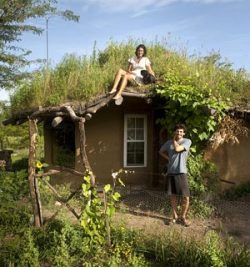 Part of the research for this right-on way of living has led me to
communes in the form of a community that works the land and is mostly
off-grid for electricity and water but are still allowed to watch DVDs
and have a mobile and don’t pray to an alien overlord. Brithdir Mawr in Wales is a good example of a commune I’d actually quite like to live
in.
Part of the research for this right-on way of living has led me to
communes in the form of a community that works the land and is mostly
off-grid for electricity and water but are still allowed to watch DVDs
and have a mobile and don’t pray to an alien overlord. Brithdir Mawr in Wales is a good example of a commune I’d actually quite like to live
in. The term ‘Eco Village’ reduces connotations to nudist colonies of cosmic beings but removes the aspect of social experimentation and people learning to live together as a community. However, Eco Villages seem more likely to be the future for the British; generally we’re a fairly unfriendly people, who delight in personal space.
- Originally posted to untroddenview.tumblr.com on 20.11.2012
So you're a gardener?
- Originally posted to untroddenview.tumblr.com on 11.09.2012
Things I learnt while working in Landscape
I worked in a Landscape practise for two months last Summer and learnt these things in my first two weeks:
1. Like prison, the currency is not money.
Cups of tea, blue and green Staedtler markers and post-it notes are far more important bargaining tools than cash. If you washed up yesterday you’re quite within your rights to refuse to buy the milk.
2. CAD bargains like the devil.
Offset, break and spline are essential but remained elusive while I was at university. The price I pay for now knowing of these elusive bits of equipment is the snap box being permanently burned into the back of my eyes. CAD is a cruel mistress.
3. Referencing is for chumps.
You can stick photos of existing projects that you may as well have produced from your posterior and it’s fine because referencing isn’t a concept that enters the mind of Landscape Architects once they’re being paid. The angel on your shoulder during your degree (tutor) has vanished and you’re free to run amok on google.
- Originally posted to untroddenview.tumblr.com on 14.08.2012
1. Like prison, the currency is not money.
Cups of tea, blue and green Staedtler markers and post-it notes are far more important bargaining tools than cash. If you washed up yesterday you’re quite within your rights to refuse to buy the milk.
2. CAD bargains like the devil.
Offset, break and spline are essential but remained elusive while I was at university. The price I pay for now knowing of these elusive bits of equipment is the snap box being permanently burned into the back of my eyes. CAD is a cruel mistress.
3. Referencing is for chumps.
You can stick photos of existing projects that you may as well have produced from your posterior and it’s fine because referencing isn’t a concept that enters the mind of Landscape Architects once they’re being paid. The angel on your shoulder during your degree (tutor) has vanished and you’re free to run amok on google.
- Originally posted to untroddenview.tumblr.com on 14.08.2012
Wildlife bridges
As much as I’m a total hippy and think the planet truly belongs
to the flowers and the bunnies, sometimes humans think of a way to be
selfish and considerate at the same time. I give you; the wildlife
bridge. Pretty mental/amazing, yes?
If I was a nitpicker (which I am), I’d say I think this particular
example could have more tree-coverage (I know the ‘clearing’ idea would
encourage the animals not to precariously set up home, but surely the
rumbling from the fast-moving vehicles means they wouldn’t linger).
This idea is also known as an ‘ecoduct’, but adding ‘eco’ to anything conjures images of aggressive unwashed people.
This is a wildlife bridge for crabs or scorpions or something. It makes me feel itchy.
- Originally posted to untroddenview.tumblr.com on 26.07.2012
I'm new here so I brought cake
Eight months ago I started a Tumblr to present 'a fresh look at Landscape Architecture' in the form of words and pictures and the occasional video; it turns out, people that use Tumblr are mainly interested in manga and nipples (sometimes both at the same time).
So I've packed up a few of my favourite posts and upgraded to Tumblr's slightly more sophisticated older sister - with her own place and nice crockery, but still not totally familiar with all the washing machine's functions or what a macchiato actually is - (that's you, Blogger).
Oh yeah, the cake:
So I've packed up a few of my favourite posts and upgraded to Tumblr's slightly more sophisticated older sister - with her own place and nice crockery, but still not totally familiar with all the washing machine's functions or what a macchiato actually is - (that's you, Blogger).
Oh yeah, the cake:
Subscribe to:
Posts (Atom)















